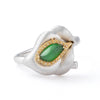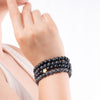Jade Bangles: Investing in Cultural Heritage and Sustainability
- by Aaron Yan

Investing in cultural heritage and sustainability can be as rewarding as it is impactful.The allure of owning a piece of history merges seamlessly with contributing to sustainable practices. These exquisite bangles not only symbolize tradition and elegance but also represent a commitment to ethical sourcing and craftsmanship. By delving into the world of jade bangles, you're not just acquiring a fashion statement; you're becoming part of an enduring legacy that values both cultural significance and environmental consciousness.
The Symbolism and Cultural Significance of Jade Bangles
Purity and Protection
Jade bangles hold a deep-rooted symbolism in Chinese culture, representing purity and protection. They are believed to ward off negative energy and bring good luck to the wearer. In traditional Chinese medicine, jade bangles are also thought to have healing properties, promoting harmony and balance within the body.
In various cultures, wearing jade bangles is considered an embodiment of spiritual significance. For instance, in ancient Mesoamerican civilizations like the Mayans and Aztecs, jade was associated with life-giving powers and used in religious ceremonies as a symbol of divinity.
Status and Wealth
Beyond their spiritual connotations, jade bangles also serve as status symbols denoting wealth. In many Asian societies, owning jade jewelry, including bangles, reflects affluence and social standing. This association with prosperity has made them highly sought after by collectors worldwide.
The cultural significance of jade bangles extends beyond aesthetics; they encapsulate centuries-old traditions while embodying sustainability through their enduring appeal. These timeless pieces not only represent heritage but also contribute to sustainable practices by promoting longevity over disposable fashion trends.
The Artistry and Craftsmanship of Jade Jewelry
Intricate Carving Techniques
Jade bangles are meticulously crafted using rough jade that undergoes a detailed carving process. Skilled artisans employ traditional techniques, shaping the real jade into exquisite designs. These intricate carvings often feature symbolic motifs such as jade dragons, phoenixes, or floral patterns. The use of high-quality jades ensures durability and longevity.
The craftsmanship involved in creating these bangles is an art form passed down through generations, with each piece reflecting the artisan's expertise and precision. For instance, when working with Siberian jade known for its stunning emerald green color and translucency, artisans carefully consider the stone's unique properties to bring out its natural beauty.
Modern Design Elements
While honoring tradition, contemporary jewelry designers also infuse modern elements into jade bangle craftsmanship. This fusion results in innovative designs that appeal to a wider audience while preserving the cultural significance of these pieces. For example, incorporating round diamonds or setting them in white gold, enhances the allure of jade bangles without compromising their authenticity.
Differentiating Jade Types and Characteristics
Varieties of Jade
Jade comes in two main varieties: nephrite and jadeite. Nephrite, known for its toughness, is often found in shades of creamy white to dark green. On the other hand, jadeite displays a broader range of colors including vibrant greens, lavender, reds, yellows, and whites.
Both types have distinct properties that make them unique. For instance, nephrite is slightly softer than jadeite but has a higher resistance to breakage due to its interlocking fibrous structure.
Identifying Genuine Jade
To distinguish genuine jade from imitations or other stones like serpentine or aventurine, it's essential to consider factors such as color, texture, and translucency. Genuine jade typically exhibits a rich color with an even distribution throughout the bangle. Its texture feels smooth yet may show subtle variations due to natural formations.
Translucency also plays a crucial role in identifying authentic jade bangles. When held against light, genuine jade will display varying degrees of transparency depending on its quality and type.
Geological Formations
Understanding the geological formations that give rise to different types of jade provides insight into their unique characteristics. Nephrite forms under high pressure metamorphic conditions while jadeite originates from subduction zones where oceanic crust descends beneath another tectonic plate.
These distinctive geological processes contribute to the diverse appearances and properties seen in nephrite and jadeite bangles.
The Mystical Origins and Historical Value of Jade
Legends and Folklore
Jade has been steeped in legends and folklore, with various cultures attributing mystical powers to this precious stone. In Chinese tradition, jade was believed to have protective qualities, bringing good luck and warding off evil spirits. It was also considered a symbol of purity, grace, and morality. This cultural significance makes jade bangles not just jewelry but also a representation of well-being.
In Mesoamerican civilizations like the Mayans and Aztecs, jade held similar reverence as a symbol of power, status, and spirituality. These beliefs elevated the cultural value of jade beyond its physical attributes, making it an integral part of ancient rituals and ceremonies.
Historical Use
Throughout history, jade has been used in various ancient civilizations for ceremonial purposes due to its esteemed value. From adorning royalty in China to being carved into intricate ornaments by the Olmec civilization in present-day Mexico, jade's historical use underscores its enduring significance across different cultures.
The practice of passing down jade bangles through generations as heirlooms further emphasizes their enduring value. They are cherished not only for their beauty but also for the rich heritage they carry within them—a testament to the lasting impact that jade has had on human culture over centuries.
Caring for Jade Bangles: Maintenance Tips
Proper Cleaning
To maintain the luster of jade bangles, it's essential to clean them properly. Use a soft, damp cloth to gently wipe the surface and remove any dirt or oils. Avoid using harsh chemicals or abrasive cleaners as they can damage the delicate surface of the jade.
When cleaning your jade bangles, consider using a mild soap solution if necessary. After cleaning, ensure that you thoroughly dry the bangles with a soft, clean cloth to prevent water spots from forming on the surface.
Protecting from Damage
Careful handling is crucial in protecting jade bangles from scratches and damage. Always store them separately from other jewelry pieces to prevent friction that could cause scratches. Avoid wearing jade bangles when engaging in activities that may expose them to impact or abrasion.
By taking these precautions, you not only preserve the beauty of your jade bangles but also contribute to sustainability in jade mining and production by reducing unnecessary replacements due to damage.
The Global Jade Market and Collector's Role
Fluctuating Prices in the Global Jade Market
The jade market experiences fluctuating prices due to factors such as scarcity, quality, and cultural significance. Rarity of certain types of jade can drive up prices, especially if they are highly sought after by collectors. The quality of the jade, including its color saturation and clarity, significantly impacts its value. Cultural significance also plays a role; for example, Burmese jade holds historical importance and is therefore highly valued.
Collectors' Role in Preserving Rare Pieces
Collectors play a crucial role in preserving rare and exceptional pieces of jade jewelry. By investing in these items, they contribute to safeguarding cultural heritage while supporting skilled artisans who create these intricate pieces. Moreover, collectors help maintain demand for high-quality traditional craftsmanship over mass-produced contemporary designs.
In recent years, there has been an emerging trend favoring antique jade bangles over contemporary ones among both investors and enthusiasts. Antique bangles are prized for their historical value and unique characteristics that reflect different periods of history or specific cultural influences.
Final Remarks
Congratulations! You've delved deep into the world of jade bangles, uncovering their rich cultural symbolism, exquisite craftsmanship, and historical significance. By exploring the diverse types of jade and understanding the sustainable practices in mining and production, you've gained a newfound appreciation for this timeless jewelry. As you care for your jade bangles, remember the global impact of your role as a collector in preserving cultural heritage and promoting sustainable practices in the jewelry industry.
Now, armed with knowledge about the global jade market and the influence of cultural diversity on jewelry design, you have the power to make informed choices. Whether you're a collector, enthusiast, or simply someone intrigued by the allure of jade bangles, your understanding of their cultural and sustainable value can drive positive change in the industry. Embrace this newfound awareness and continue to explore the beauty and significance of jade bangles with a mindful and sustainable approach.
Frequently Asked Questions
What is the cultural significance of jade bangles?
Jade bangles hold deep cultural symbolism in various cultures, representing purity, protection, and prosperity. They are believed to bring good luck and ward off negative energy. In many traditions, jade symbolizes harmony and balance.
How can I differentiate between different types of jade?
Differentiating between types of jade involves examining their color, translucency, texture, and luster. Nephrite typically appears in creamy white to dark green hues with a waxy sheen, while jadeite showcases a wider range of colors including vibrant greens and lavender.
How should I care for my jade bangles?
To maintain the beauty of your jade bangles, avoid exposing them to harsh chemicals or extreme temperatures. Clean them gently with a soft cloth or brush using mild soap and water. Store them separately from other jewelry pieces to prevent scratching or damage.
What role does cultural diversity play in designing jade jewelry?
Cultural diversity greatly influences the design aesthetics of jade jewelry. Different regions infuse their unique heritage into crafting intricate designs that reflect diverse artistic styles and traditional motifs. This fusion creates an array of stunning pieces that celebrate global cultural richness.








